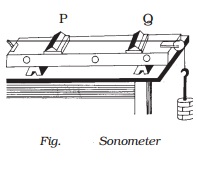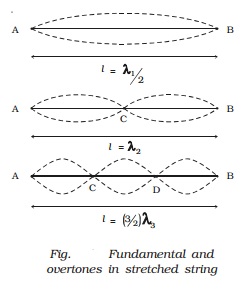Chapter: 11th 12th std standard Class Physics sciense Higher secondary school College Notes
Standing waves in strings - Sonometer

Standing waves in strings
In musical instruments
like sitar, violin, etc. sound is produced due to the vibrations of the
stretched strings. Here, we shall discuss the different modes of vibrations of
a string which is rigidly fixed at both ends.
When a string under
tension is set into vibration, a transverse progressive wave moves towards the
end of the wire and gets reflected. Thus stationary waves are formed.
Sonometer
The sonometer consists
of a hollow sounding box about a metre long. One end of a thin metallic wire of
uniform cross-section is fixed to a hook and the other end is passed over a
pulley and attached to a weight hanger as shown in Fig.. The wire is stretched
over two knife edges P and Q by adding sufficient weights on the hanger. The
distance between the two knife edges can be adjusted to change the vibrating
length of the wire.
A transverse
stationary wave is set up in the wire. Since the ends are fixed, nodes are
formed at P and Q and antinode is formed in the middle.
The length of the
vibrating segment is l = λ/2
∴ λ = 2l. If n is the frequency of vibrating segment, then n = v/
λ = v /2l
We
know that v = root(T/m) where T is the tension and m is the mass per unit
length of the wire.
N=1/2l.root(T/m)

Modes of vibration of stretched
string
(i) Fundamental frequency
If
a wire is stretched between two points, a transverse wave travels along the
wire and is reflected at the fixed end. A transverse stationary wave is thus
formed as shown in Fig..
When
a wire AB of length l is made to vibrate in one segment then l = λ1/2
.
∴ λ1 = 2l. This gives
the lowest frequency called fundamental frequency n1=v/λ1.
n1
= 1/2l.root(T/m) ?????.(3)

(ii) Overtones in stretched string
If
the wire AB is made to vibrate in two segments then l = λ2/2 + λ2/2
λ2
= l.
But,n2
= v/ λ2
n2
= 2n1
n2
is the frequency of the first overtone.
Since
the frequency is equal to twice the fundamental, it is also known as second
harmonic.
Similarly,
higher overtones are produced, if the wire vibrates with more segments. If
there are P segments, the length of each segment is
l/p
= λp/2
or
λp
= 2l/P
Frequency
nP = P/2l. root[T/m]
=Pn1
(i.e)
Pth harmonic corresponds to (P?1)th overtone.
Laws of transverse vibrations of stretched
strings
The laws of transverse
vibrations of stretched strings are (i) the law of length (ii) law of tension
and (iii) the law of mass.
(i) For a given wire (m is constant), when T is constant, the fundamental frequency
of vibration is inversely proportional to the vibrating length (i.e)
n
α 1/l
or
nl = constant.
(ii)
For constant l and m, the fundamental frequency is directly proportional to the
square root of the tension (i.e) n α root[T].
(iii)
For constant l and T, the fundamental frequency varies inversely as the square
root of the mass per unit length of the wire (i.e) n α 1/ root[m].
Related Topics